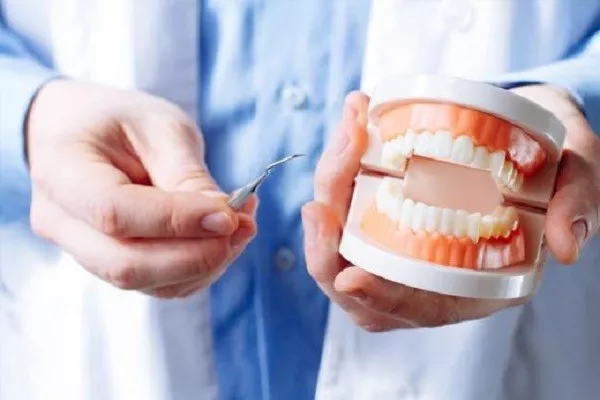Periodontal disease is a serious condition that affects the gums and bones supporting the teeth. If left untreated, it can lead to tooth loss and other health complications. In this article, we will discuss what periodontal disease is, how it is diagnosed, and how long it takes to cure.
What is Periodontal Disease?
Periodontal disease, also known as gum disease, is a bacterial infection that affects the gums and supporting structures of the teeth. The early stage of periodontal disease is called gingivitis, which is characterized by red, swollen, and bleeding gums. If left untreated, gingivitis can progress to periodontitis, which is a more advanced stage of the disease. Periodontitis can cause damage to the gums, bones, and tissues that support the teeth, leading to tooth loss.
Diagnosis of Periodontal Disease
Periodontal disease is diagnosed by a dentist or periodontist through a series of tests and evaluations. The dentist or periodontist will examine the gums, teeth, and surrounding tissues for signs of inflammation, bleeding, and bone loss. They may also use x-rays to determine the extent of bone loss and damage to the supporting structures of the teeth.
Treatment of Periodontal Disease
The treatment of periodontal disease depends on the severity of the disease. In the early stages, the treatment may involve a deep cleaning procedure called scaling and root planing. Scaling and root planing involves removing the plaque and tartar from the teeth and smoothing out the roots to promote the healing of the gums.
In more advanced cases, the treatment may involve surgery. There are several types of surgery that may be performed, including pocket reduction surgery, bone grafts, and tissue regeneration. The type of surgery that is performed will depend on the severity of the disease and the extent of the damage to the gums and supporting structures of the teeth.
How Long Does It Take to Cure Periodontal Disease?
The length of time it takes to cure periodontal disease depends on several factors, including the severity of the disease, the effectiveness of the treatment, and the patient’s overall health. In general, it takes several months to a year to fully cure periodontal disease.
During the initial stages of treatment, the patient will need to visit the dentist or periodontist more frequently for follow-up appointments to monitor the progress of the treatment. The patient will also need to maintain good oral hygiene at home by brushing and flossing regularly and using an antimicrobial mouthwash.
Once the disease is under control, the patient will need to continue with regular dental visits and maintain good oral hygiene to prevent the disease from returning. The dentist or periodontist may also recommend lifestyle changes, such as quitting smoking, to improve the overall health of the gums and teeth.
Factors That Affect the Length of Treatment
Several factors can affect the length of treatment for periodontal disease. These factors include:
- Severity of the Disease
The severity of the disease is one of the most significant factors that affect the length of treatment. In general, the more advanced the disease, the longer it will take to cure.
- Effectiveness of the Treatment
The effectiveness of the treatment also plays a role in the length of treatment. If the treatment is effective, the disease will be cured faster. However, if the treatment is not effective, the disease may take longer to cure or may require additional treatment.
- Patient’s Overall Health
The patient’s overall health can also affect the length of treatment. Patients with underlying health conditions, such as diabetes or heart disease, may take longer to cure periodontal disease. Additionally, patients who smoke or have poor oral hygiene may also take longer to cure periodontal disease.
- Compliance with Treatment
Compliance with the treatment plan is another important factor that affects the length of treatment. Patients who follow their dentist or periodontist’s instructions and maintain good oral hygiene at home are more likely to cure the disease faster than those who do not.
- Genetics
Genetics can also play a role in the development and progression of periodontal disease. Some people may be more prone to developing the disease, while others may have a higher risk of developing severe forms of the disease.
Preventing Periodontal Disease
Preventing periodontal disease is key to maintaining healthy gums and teeth. Here are some steps you can take to prevent periodontal disease:
- Brush and Floss Regularly
Brush your teeth at least twice a day and floss at least once a day to remove plaque and food particles from your teeth and gums.
- Use an Antimicrobial Mouthwash
Use an antimicrobial mouthwash to kill bacteria in your mouth and reduce the risk of developing gum disease.
- Quit Smoking
Smoking is a significant risk factor for periodontal disease. Quitting smoking can improve your overall health and reduce the risk of developing gum disease.
- Maintain a Healthy Diet
Eat a healthy diet that is rich in fruits and vegetables and low in sugar and processed foods. A healthy diet can improve your overall health and reduce the risk of developing gum disease.
- Visit the Dentist Regularly
Visit your dentist or periodontist regularly for routine check-ups and cleanings. Regular dental visits can help detect and treat gum disease early.
Conclusion
Periodontal disease is a serious condition that can lead to tooth loss and other health complications if left untreated. The length of time it takes to cure periodontal disease depends on several factors, including the severity of the disease, the effectiveness of the treatment, and the patient’s overall health. It is important to practice good oral hygiene and visit your dentist or periodontist regularly to prevent and treat periodontal disease. By following these steps, you can maintain healthy gums and teeth for a lifetime.
Related Topics:































